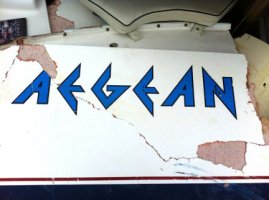Egg Shells and other observations
There is insufficient data at this point for me to even guess at what happened out there before during or after this accident.
However a couple of observations:
Surfers die from a combination of head trauma and drowning all the time and they are on a beach.
The boats that we love are really egg shells when compared to rocks and the waves that break on them. Yes we have photos and stories of boats sitting high and dry with all of their hardware removed, but they were for the most part washed high while floating over the rocks, and then dropped.
I have seen a few of these boats myself, most of them have the unseen side completely destroyed. If the boat is between rocks and the surf there is little left of it in short order. Imagine picking up your thousands of pounds of boat and dropping it repeatedly on a parking lot. Something like every 8 seconds for an hour or so. It does break up into little pieces fast.
So while we are waiting on some more hard data to come in on this tragedy, rather than guessing at what happened, lets talk about what can make passages safer and prevent any of the incidents that could have been the cause of this.
Do you wear a digital watch with a loud alarm offshore? I wear a Casio G-shock with a countdown timer set to 7 minutes. Every seven minutes it goes off. It is loud enough that I have always done an entire sweep of the horizon when it goes off. Is 7 minutes the best time to set it for? Probably not. A complete sweep of the horizon should be done more like every 2 minutes if we are seeking to avoid a collision with a cargo vessel.
A little light Wednesday Morning Math stretch for our brains explains why.
1.17*sqr(he)=distance in NM of Sight (He stands for height of eye) This gives you the distance to your horizon.
Lets say our height of eye was 7 feet for arguments sake. (What is yours on your boat? Standing in the cockpit looking out the dodger?)
1.17*sqr(7)=roughly 3 miles (Our horizon is about 3 miles away when our eye is 7 feet above the surface of the water).
Lets say a cargo ship is steaming towards us at 25 knots, we are ripping along with a bone in our teeth at say 6 knots. Lets also say we are headed right for each other. How long would it be from the time I saw the ship till we collided?
25 knots (Speed of ship) + 6 Knots (wow we are really sailing well aren't we!) = 31 Knots of boat speed for a head on collision 25 knots for the cargo ship 6 knots for your boat headed directly for one another.
31 knots / 60 minutes is about .5 of a mile in a minute. That means that you are about 1/2 a mile closer to each other every minute.
That means from the time that you can see them (Yes that would be Hull Up on the water) till the time that you hit them would be:
3 miles (The distance to our horizon) / .5 (knots per minute of decreasing distance) is about 6 minutes.
Now there are things that effect this and make the calculation more complex. Height of the object above the water, Height of the waves (Both a positive and negative effect), weather conditions, light refraction and reflection over the horizon during the day, and at night; just to name a few.
I have purposely made the equation easier than the complete system is to get us ALL thinking about it, and people not running away screaming Math!!!!!!
So in the time between my alarms going off on my watch I could have completely missed the boat headed toward me and been run down with a minute left to spare. Exhaustion on watch is a very real cause of a lot of collisions, allisions, and other bad things.
Guy


